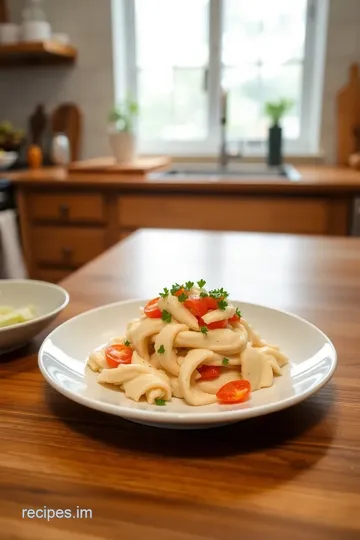Easy Dissolution of Disodium EDTA: A Step-by-Step Guide
Curious about how to dissolve Disodium EDTA in your cooking? Let me share my kitchen-tested steps for effortlessly blending this ingredient into your recipes!

- Dissolving Disodium EDTA in Simple Steps: Your Ultimate Guide
- Your Go-To Essential Ingredients Guide
- Getting Started with Professional Cooking Methods: Easy Dissolution of Disodium EDTA
- Pro Tips & Secrets: Mastering the Art of Dissolving Disodium EDTA
- Perfect Presentation: Visual Appeal Counts
- Storage & Make-Ahead: A Chefs' Best Friend
- Creative Variations: Mix it Up!
- Complete Nutrition Guide: Eat Smart
- Expert FAQ Solutions: You Got Questions, I Got Answers!
- Final Thoughts: Embrace Your Kitchen Chemistry Adventure!
- Recipe Card
Dissolving Disodium EDTA in Simple Steps: Your Ultimate Guide
Opening Hook
Oh my gosh, let me tell you about the time i tried making a homemade pasta sauce that tasted flat and boring.
You know those moments when you realize you forgot to add that secret ingredient ? well, i needed a little something to enhance the flavor, and that’s when i stumbled upon the magical world of disodium edta.
I was curious: can i really dissolve disodium edta in simple steps? well, i figured it out, and now i can’t imagine cooking without it! this little chelating agent is a total game-changer for food preservation and flavor enhancement.
So, if you’re all about elevating your cooking game, let’s dive into how to dissolve disodium edta and make your culinary creations shine!
Recipe Overview
Disodium edta has been around for decades, primarily in the food industry and even pharmaceuticals. originally, folks started using it as a chelating agent to keep food fresh longer and improve texture.
Nowadays, it's a hit among home cooks who want to preserve their ingredients and maintain that just-made flavor. it’s super relevant right now, with many people looking to avoid artificial preservatives.
The best part? this whole process takes 5 minutes, and it’s so easy you won’t break a sweat!
When it comes to cost, disodium edta is surprisingly affordable. you only need about a teaspoon for a full cup of dissolved solution, which goes a long way in your cooking adventures.
With just a bit of powdered product and some distilled water, you’re ready to create culinary magic!
Key Benefits
Let’s chat about the benefits of using disodium edta. first off, it’s remarkable for enhancing flavor stability . that means your sauces and dressings will taste fresh longer! it also plays a significant role in food preservation techniques, keeping your meals safe without using harmful chemicals.
Plus, it’s perfect for special occasions when you want everything to taste just right. who doesn’t want their holiday dinner to be unforgettable?
When you think about it, using disodium edta in your kitchen gives you a leg up on other preserved products.
You get that homemade taste but with the safety of modern ingredient manipulation. and let’s be real: it’s way cooler to say you made a sauce with a chelating agent than just adding some store-bought stuff, right?
Now, let’s transition smoothly into the ingredients. we’re talking about just two simple items: disodium edta and distilled water . simple enough that even your kids can help, and easy enough to make this part of your cooking routine.
Ready to get started? let’s break down how to actually dissolve disodium edta and make it work for your recipes.
Quick reminder: make sure you have all your tools and ingredients ready before beginning. The more organized you are, the better the outcome!
Ingredients for Dissolving Disodium EDTA
- Disodium EDTA: 1 teaspoon (5 grams)
- Distilled Water: 1 cup (240 mL)
Will you believe that’s it? with those two ingredients, your kitchen will be on its way to creating incredible stability and flavor depth in your dishes.
Time to roll up those sleeves and whip out that mixing bowl!

Your Go-To Essential Ingredients Guide
Alright, friends! let’s dive into the wonderful and sometimes confusing world of ingredients. you know how it feels when you’re at the grocery store, staring at a shelf full of options? yep, i’ve been there too! we’re bringing clarity to it all today with this essential ingredients guide .
Premium Core Components
Measurement matters: first off, you gotta know how to measure. for instance, 1 teaspoon of disodium edta weighs about 5 grams .
If you're in america, that’s your gold standard. if you’re using the metric system, think of it like this: 240 ml equals 1 cup .
No guesswork here!
Quality to Look For: When you’re picking out ingredients, check for quality indicators. For Disodium EDTA, look for a fine white powder without clumps. Freshness is key!
Storage like a pro: keep your pantry organized. most dry ingredients last a while, but proper storage is a game changer.
Tightly sealed containers in a cool, dry place are perfect. a general rule? use within one to two years after opening.
It’s all about those food preservation techniques !
Selection Tips: Freshness is critical. For herbs, when you’re at the store, give them a sniff. If they smell vibrant? Win!
Signature Seasoning Blend
Time to jazz things up with some signature seasoning blends ! whether you’re a spice ensoiast or just starting, try combining cumin, paprika, and garlic powder for a smoky kick.
Honestly, it’s the stuff dreams are made of!
For herbs, think about classic pairings. Basil and tomatoes? Can’t go wrong. You can even throw in some Disodium EDTA for that added shelf stability in your sauces!
Smart Substitutions
Okay, let’s face it—life happens, and sometimes you don’t have all the right ingredients. that’s where smart substitutions come into play! need a quick fix? try using lemon juice instead of vinegar in some recipes if you’re in a pinch.
And speaking of being resourceful, if you're out of disodium edta, you'd better know that alternatives like citric acid can step in for the win!
Let’s not forget about dietary modifications! Making your dishes gluten-free or vegan just requires a little creativity. Swap in zucchini noodles for pasta, and trust me, you won’t miss it!
Kitchen Equipment Essentials
Alright, now let’s chat about tools! you don’t need fancy gadgets. a good set of measuring spoons and a mixing bowl is all you really need.
Need to amalgamate those powders in liquids? think whisk for aerating and stirring. it’s like magic!
Storage solutions , like glass jars , are super helpful. When you store your ingredients properly, they last longer and you’ll save cash in the long run!
Wrapping Up
Phew! that was a lot, but isn’t it satisfying to understand your ingredients better? when you know what you're working with, it's like unlocking a new level in cooking.
Now, let’s not forget about that all-important step: dissolving disodium edta in simple steps .
Understanding how to dissolve Disodium EDTA can make a world of difference in your cooking adventures. Plus, those chelation properties are essential for food safety and preservatives .
So, grab your measuring spoons, and let’s get to the fun part—actually cooking. you’ll find the step-by-step instructions coming right up.
Trust me; soon, you’ll be the one teaching all your friends how to create magic in the kitchen!
Getting Started with Professional Cooking Methods: Easy Dissolution of Disodium EDTA
Cooking is like an adventure, isn’t it? and just like any journey, you have to be prepared. when you're diving into professional cooking methods , there are essential steps that can help you along the way.
One intriguing part of this is learning to dissolve disodium edta in simple steps ! at first glance, it might sound a bit intimidating, but trust me, it's easier than it looks.
Essential Preparation Steps
Mise en place is a fancy french term, but let’s call it what it really is: organizing your kitchen before you start.
Gather all your ingredients and tools so you won't be scrambling at the last minute. for this little project, grab 1 teaspoon (5 grams) of disodium edta and 1 cup (240 ml) of distilled water .
Now, let's talk time management . You don’t want to waste precious moments looking for stuff. Try to check everything off your list before you even step into the kitchen.
Safety is key, especially when working with ingredients like disodium edta, which is often used as a chelator in food preservation.
Just remember to handle everything with clean hands and ensure your workspace is tidy.
Step-by-Step Process
Ready? Here’s how to do it in a clear and easy way.
-
Measure the Disodium EDTA first.
- Use your measuring spoon for 1 teaspoon (5 grams) .
-
Get the distilled water ready.
- A measuring cup will help you nail down that 1 cup (240 mL) .
-
Combine them.
- Dump the Disodium EDTA into the distilled water in a mixing bowl.
-
Stir it up!
- Use a whisk or stirrer to mix it until dissolved.
-
If needed, give it some heat.
- If it’s not dissolving well, gently heat it. Just don’t let it boil! Stir continuously until it all blends.
You’re looking for a clear solution here with no gritty bits—this is your cue that you've nailed the dissolution process.
Expert Techniques
Let’s say you want to use disodium edta beyond the basics. first, it's essential to know that this chelating agent helps in food preservation and enhances flavor.
So, how do we get that perfect mixture?
Keep an eye on two main checkpoints: temperature and time . Make sure you’re stirring consistently—this isn’t a set-it-and-forget-it type of deal. Continuous stirring aids in breaking that powder down.
If you're struggling, don't stress! sometimes, adding a splash more distilled water can help. if it still doesn’t work, you might need to adjust your approach.
Try testing the solution by checking if it’s clear; imperfections mean you've got some troubleshooting ahead.
Success Strategies
Now, let’s talk about common mistakes that can trip you up. overheating the mixture can break down the edta, so keep the heat low and slow.
Always use distilled water —it’s essential for maintaining the stability of your ingredients.
A cool tip? you can whip this solution up ahead of time and store it in an airtight container for easy future use.
This gives you flexibility for recipes down the road—think homemade sauces that need stabilizers!
Wrapping It Up
Professional cooking methods may feel daunting, but with things like disodium edta , you’re stepping into the world of food chemistry for beginners .
The benefits of using chelating agents in cooking go beyond flavor; they improve shelf life and quality.
Before you dive into additional information , remember that learning how to manipulate ingredients—like dissolving powders in liquids—is a stepping stone on your culinary journey.
Plus, it’s a fun way to get creative! have fun experimenting, and watch your dishes come to life. whether for a family meal or some fancy hors d'oeuvres, mastering these methods is sure to elevate what you cook up in the kitchen!

Pro Tips & Secrets: Mastering the Art of Dissolving Disodium EDTA
So, you wanna to dissolve disodium edta in simple steps ? you’ve come to the right place! honestly, what an underappreciated ingredient this is for us home cooks.
It’s not just some nerdy food science; it's a game changer in the kitchen. let's dive into some of my personal insights and handy techniques to ensure you nail this process.
First off, time-saving techniques are key. when i was first getting my feet wet in the kitchen chemistry pond, i struggled a bit with this step.
But here’s a little secret i learned: gently heating the water while stirring speeds up the dissolution process like you wouldn't believe! just be careful—you don’t want to boil it, because that's a whole different type of trouble.
Not to be left out in the flavor department, let's talk about enhancing that taste! adding herbs or spices to the distilled water before introducing the disodium edta can bring a new dimension to your food.
Trust me, it makes a difference! think about a hint of basil or a touch of garlic in a sauce designed to last.
Perfect Presentation: Visual Appeal Counts
Okay, moving on to the fun part— presentation ! now, while we’re talking about dissolving disodium edta, you gotta think about how you’ll use that clear solution.
When you’re mixing it into sauces or even using it for preserving food, plating is everything!
Use a shallow dish to pour in your dish and let the dissodium edta-infused sauce pool beautifully in the center.
Honestly, it’s all about that eye candy! garnish with a sprinkle of fresh herbs or a twist of citrus. those color combinations can elevate your dish more than you think.
Visual appeal is not just about tasting good; it’s about looking good too!
Storage & Make-Ahead: A Chefs' Best Friend
Let’s get practical—what happens if you make a batch of dissolved disodium edta and don’t use it all? no stress! just store it in an airtight container in a cool, dark place.
This stuff has a decent shelf life, which is great for us busy bees.
Remember, the freshness duration is usually quite long, but it’s always a good practice to label your container with the date you made it.
A little piece of tape goes a long way in the kitchen!
Reheating is a breeze. just allow it to come to room temperature before using, or gently warm it in a saucepan.
But please, don’t boil! we want to keep that chelating power intact.
Creative Variations: Mix it Up!
Let’s shake things up with some creative variations . you can easily adjust the concentration of your disodium edta solution based on your personal need.
Want something lighter? less is more! curious about a seasonal twist? use some flavored distilled water —think rosemary or mint!
And hey, some folks dive into dietary modifications . if you’re looking for a natural chelator, consider trying citric acid instead.
With the science behind food being super cool, experiment a little. it's all about finding what works best for you!
Complete Nutrition Guide: Eat Smart
Before you head off on your culinary adventure, we need to talk about nutrition—especially since we’re dealing with dissodium edta.
There’s not much nutritional value , but it does help keep your food safe, which is a bonus. understanding the dietary considerations around this ingredient is essential, especially if you're watching sodium intake or food safety.
As a guideline, keep those servings moderate. This isn’t about piling on the stuff, but using it wisely in delicious sauces and preserved veggies.
Expert FAQ Solutions: You Got Questions, I Got Answers!
I know you might have some burning questions! Let's tackle a few common ones.
Is Disodium EDTA safe? Yep, used correctly, it’s totally fine. If you’re wondering how to use Disodium EDTA effectively, just remember: start small! You’ll get a feel for it in no time.
And if the dissolution process in cooking doesn’t seem to be going as planned, don't stress. just keep stirring and maybe try a pinch of salt or a little warmth to help things along.
Final Thoughts: Embrace Your Kitchen Chemistry Adventure!
In the end, remember that cooking is all about having fun! don’t shy away from easy food chemistry —embrace it! dissolved disodium edta can help you preserve your food and elevate your dishes to another level.
So go on, give it a shot! With these tips, tricks, and a little patience, you’ll be a whiz at using this unique ingredient in your kitchen in no time. Happy cooking!

Easy Dissolution of Disodium EDTA: A Step-by-Step Guide Card

⚖️ Ingredients:
- 1 teaspoon Disodium EDTA (5 grams)
- 1 cup distilled water (240 mL)
🥄 Instructions:
- Step 1: Use a measuring spoon to measure 1 teaspoon (5 grams) of Disodium EDTA.
- Step 2: Measure 1 cup (240 mL) of distilled water using a measuring cup.
- Step 3: In a mixing bowl, add the Disodium EDTA to the measured distilled water.
- Step 4: Use a whisk or stirrer to mix the two components together. Stir continuously until the Disodium EDTA is fully dissolved.
- Step 5: If the Disodium EDTA is not dissolving readily, gently heat the mixture (do not boil) to increase solubility. Stir continuously while heating until dissolved.
- Step 6: Transfer the solution to a heat-safe container for future use or immediate incorporation into recipes.
Previous Recipe: Easy Bake Victoria Sponge Cake: Delightfully Sweet Classic You’ll Love
Next Recipe: How to Bake Chicken Thighs: Juicy & Flavorful Delight in 5 Easy Steps
